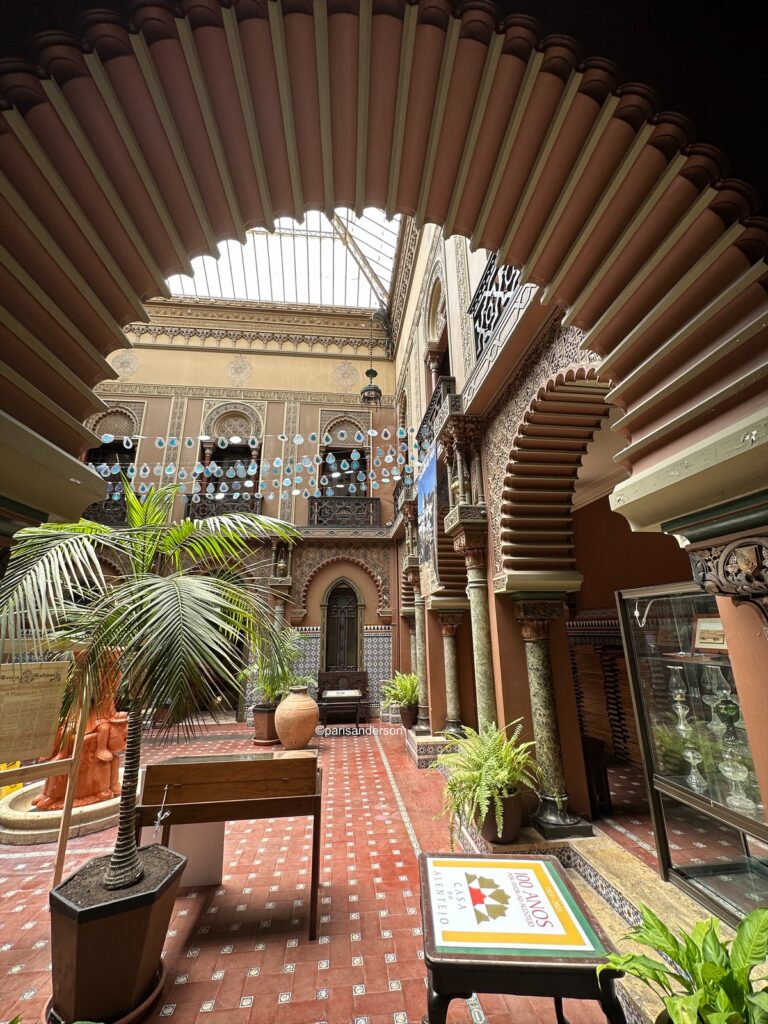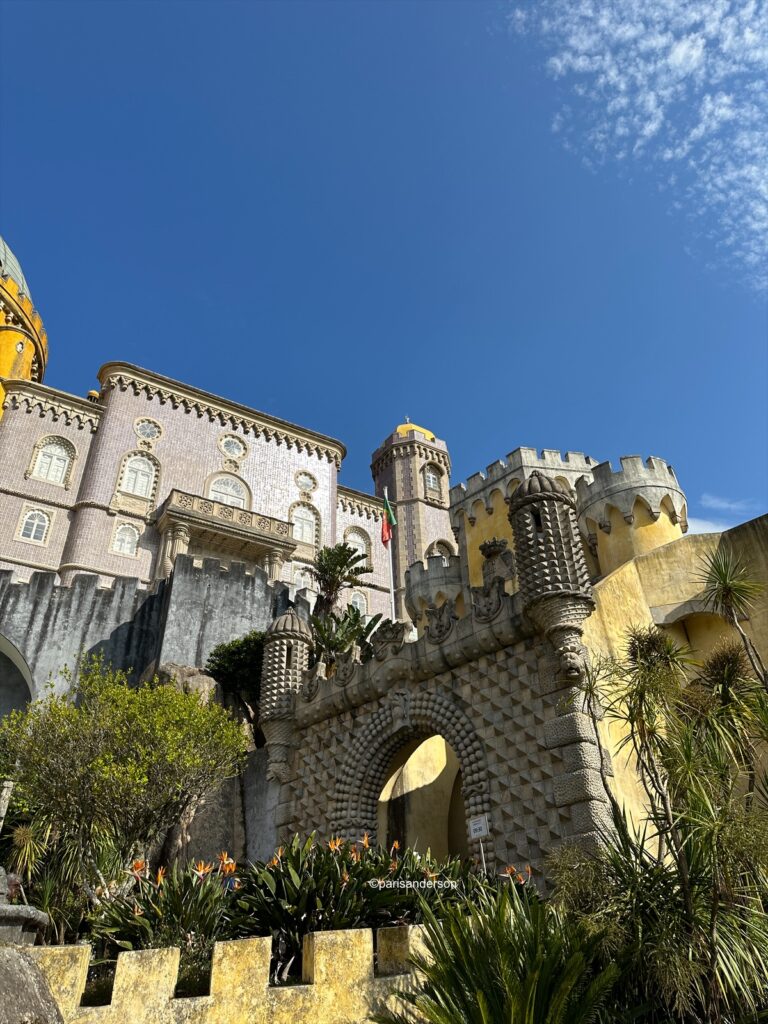The perfect guide to spending 2 days in Lisbon, Portugal. It shares all of the must-do, must-see attractions that the city has to offer.

On our second visit to Lisbon, we had an amazing time exploring more of the city than we got to last time. Lisbon is such a beautiful city nestled among seven hills. It is the second oldest city in Europe (after Athens) and is the capital of Portugal. Lisbon is extremely walkable (this can be tiring with all the hills, however, there are conveniently located elevators).
I highly recommend if this is your first visit to walk around and explore the central areas of Lisbon: Alfama, Baixa, and Bairro Alto/Chiado. If you would like through walking directions, this post is a good source.
Central Lisbon
Carmo Convent
Carmo Convent and its church were built between 1389 and 1423 in the Gothic style. In 1755 when the devastating earthquake destroyed most of Lisbon it also destroyed Carmo Convent – collapsing the roof in on the congregation. Today you can tour the open-air nave, admire the gothic arches, and see an eclectic collection at the archeological museum including Peruvian mummies.

Santa Justa Lift
The perfect way to admire the Santa Justa Lift is from the top and the best part is then you do not have to wait in line. If you are standing facing Carmo Convent, follow the road along the right side of the building. Then you can take photos of Lisbon with the lift in your picture. You can also walk onto the beautiful structure and get the same view you would have gotten if you would have waited in line to ride it.

Livraria Bertrand
The oldest bookstore in the world that is still in operation is Livraria Bertrand. This is a must-visit for any book lovers and if you purchase a book you can ask to have it stamped with the bookstore logo inside.
Miradouro de São Pedro de Alcântara
This terrace has sweeping panoramic views of the city. Some mornings there is a market with vendors selling goods. If you are looking for a bakery nearby Padaria Patriarcal is gorgeous inside and only about a three-minute walk from the overlook.
Casa do Alentejo
Built in the 1600s, Alverca Palace now called Casa do Alentejo was the residence of the Paes de Amaral family. The Moorish-style courtyard inside the building is beautiful and I recommend stopping in for a quick look around. There is a restaurant on the upper floors open only during select hours, however, you can visit the courtyard for free throughout the day.

Igreja de São Domingos
This church dating from 1241 near Rossio Square was once one of the most predominant churches in Lisbon. While the majority of the church has been rebuilt due to the 1755 earthquake and a fire that completely destroyed its interior in 1959, the church today shows its scars and a combination of different architectural styles.
Church of São Domingos is the site of a three-day massacre in 1506 where hundreds of Jews were persecuted and killed. In the square outside of the church, there is a monument mural that pays tribute to the Jewish victims of the 1506 massacre. The square is also home to the famous ginjinha cherry brandy.

Castle of São Jorge
Because of the location of the Castle of São Jorge on Alfama Hill, you will be able to see the towers and walls from around the city. While the site of the castle was used by the Romans all the way back in 200 BC, the castle was built in the 5th century and enlarged in the 9th century by the Arabs. It underwent a complete restoration in the 1940s. The castle grounds are large with 11 towers and walls to explore, beautiful views of the city, gardens to relax in, and a small museum. While the castle has a fee to visit, you can wander inside the outer castle walls for free. Here you can see the statue of Saint George near the arch of the outer castle walls and explore the streets and alleyways that make up this area of Lisbon.
Miradouro de Santa Luzia
This viewpoint offers lovely views of the city of Lisbon and the Tagus River. The viewpoint itself is gorgeous with columns and tiles.

Miradouro das Portas do Sol
The views from this viewpoint are even more spectacular of the city and it is just a couple of steps from Miradouro de Santa Luzia.
Pastelaria Santo António
This is the perfect place to stop on your way to or from the viewpoints for a pastel de nata.
Lisbon Cathedral
The Lisbon Cathedral was built in the 12th century and has two bell towers, a central rose window, and Romanesque-style architecture. Inside you will find a fountain in which Saint Anthony of Padua was baptized, Gothic cloisters similar to the ones at Jerónimos Monastery, and a treasury filled with jewels and relics. This cathedral does cost to go inside.

St. Anthony’s Church
Saint Anthony was born in Lisbon (on the site of this church). He is the patron saint for the recovery of lost things and protector of young brides. There are painted tiles commemorating Pope John Paul II visit to the church in 1982.
Arco da Rua Augusta
A beautiful 18th-century arch located just off the Praça do Comércio. It was built to commemorate the city’s reconstruction after the 1755 earthquake. You can pay a couple of euros a person to go to the top to see views of the city center of Lisbon.
Pink Street
Originally Lisbon’s red light district, Rua Nova do Carvalho has been revitalized and is now better known as “Pink Street”. It is one of the hottest areas in town for nightlife where locals and tourists party until dawn.
Elevador da Bica
One of the famous photos of Lisbon is of the Elevador da Bica – this tram climbs up the steep street: Cais do Sodre with the Tagus River in the background. The tram entrance is tucked into the arch of a building on Rua de São Paulo, 234. Look for the sign over the arch.

Outside of Central Lisbon
Belém Tower
This 16th-century medieval fortified tower is located along the Tagus River to the west of Lisbon. It serves as a monument to Portugal’s Age of Discovery. The inside is open for tours however in my opinion the best is seeing the tower from the outside. You can take tram 15 out to visit Belém or a taxi/Uber.

Jerónimos Monastery
While in Belém and just a couple minute walk from the Belém Tower is Jerónimos Monastery which is the former monastery of the Order of Saint Jerome. It is a Gothic monastery built shortly after Vasco da Gama’s historic 1498 voyage to India. The Church of Santa Maria de Belém is attached to the monastery and is free to visit. Separately, the monastery and its famous cloisters are in the ticketed portion of the monastery. Vasco da Gama’s tomb is located at the Church of Santa Maria de Belém.
Both the Belem Tower and Jerónimos Monastery came through the 1755 earthquake mostly unscathed.


Pastéis de Belém
This pastry shop is one of the most famous places in Lisbon to get a Pastel de Belem (custard tart). You can skip the long takeaway line and sit down in the restaurant to enjoy this treat or other snacks.

More places to see in Belem include Garden Vasco da Gama and Padrão dos Descobrimentos. Garden Vasco da Gama might just look like a park however it has a beautiful Thai pavilion in it. Padrão dos Descobrimentos is a monument on the northern bank of the Tagus River that celebrates 15th and 16th Portuguese explorers.
If you have more time you may also enjoy Museu Nacional do Azulejo (Tile Museum) or Palácio dos Marqueses de Fronteira (Fronteira Palace). The Tile Museum has five centuries of decorative ceramic tiles on display along with the history of tile making. This museum is breathtakingly beautiful and a great spot to take photos too. The palace was built in the 17th century and is located northwest of the city center. It is best known for its beautiful formal gardens with some of the finest tiles in the county.

Day Trip to Sintra
If you have more days in Lisbon and are looking to explore outside the city I highly recommend taking the train to Sintra to explore the grand mansions that have whimsical and playful designs. Each mansion is completely different from the others and beautiful. You can read more about taking a day trip to Sintra from Lisbon in this blog post.




